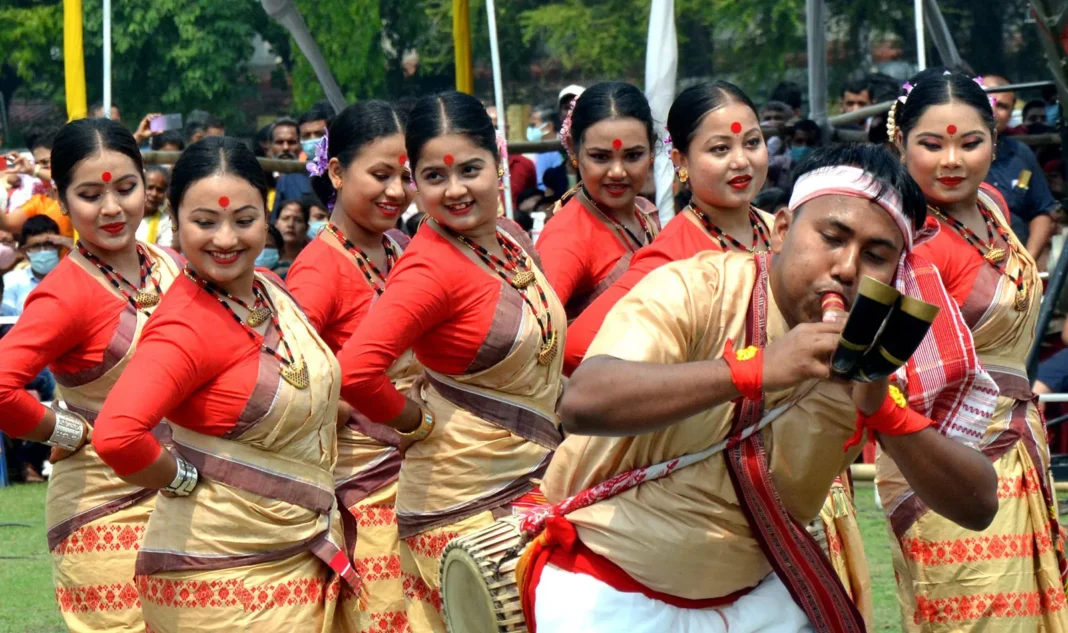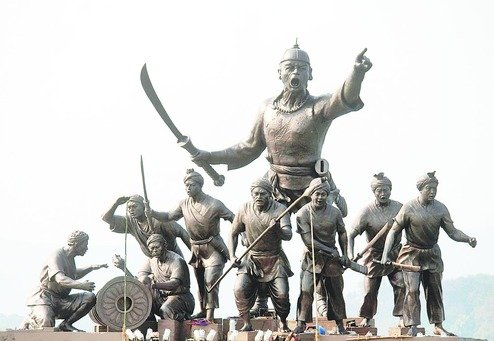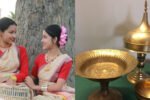By: Arup Saikia
The inferred historical events or period of Assam began with the reign of Pushya Varman, the first king of the Varman dynasty. Previously, no verified history could be found about the legendary Asura or Danava dynasty mentioned in Hindu mythology. The Gupta Empire of northern India, led by Chandragupta II in 375 AD, coincided approximately with the accession of Pushya Varman in 380 AD. Chandragupta II, popularly known as Vikramaditya, was a legendary king known for his fame, achievements, skills, attitude, and personality.
The Varman Dynasty of Pragjyotishpur (modern-day Kamrup) was influenced by the renowned characteristics of the Gupta period. From this time onwards, the language, religion, art, and literature of the Aryan civilization entered the Brahmaputra Valley more strongly than ever before, sweeping across the north and south banks of the Brahmaputra. Assamese overall food habits, the judgment of casteism, and various religious sects such as Vaishnavism, Shaktism, Shaivism, and Buddhism flowed from the Aryan land. Although it is noteworthy to mention that the Aryan language and culture came to Pragjyotishpur from the fifth century BC onwards, these ties became stronger during the Varman period.
A significant portion of immigrants to the Brahmaputra Valley naturally felt an attraction to Aryan civilization. The names of kings and queens were adopted from Sanskrit words, and even the name of the ancient king Mairanga Danav was reinterpreted as Mahidanav. The names of some places were also derived from Aryan-ruled kingdoms. During this period, a common language developed, and Sanskrit was made compulsory for the upper class.
The primary theoretical history of the Assam people is composed of a mixture of Mongolian and Caucasian materials, while the cultural history of the Assam people is composed of the culture of Southeast Asia, Aryan, and Dravidian influences. The establishment of the Salastambha and later the Pala dynasty occupies an important chapter in the history of ancient Assam and contributed to the process of Aryanization regardless of their origin. Although the Varmans and the Palas claimed or accepted their lineage from the Narakasur dynasty, the Palas are somehow related to non-Caucasian origins. Starting from writings or inscriptions about Bhaskar Varman and others, no writers addressed any king as “Mlech” (dialect speaker, non-Caucasian). However, the term “Mlech” is used before the Pala kings. Regardless of their blood lineage, Aryan influence was predominantly initiated by the Varmans, and all subsequent dynasties preached the great Indian Aryan culture.
The end of the Pala dynasty marked the beginning of the medieval period. Almost all major dynasties of medieval Assam were of “Kirata” or Indo-Mongolian origin. Relinquishing their traditional age-old faith, they gradually embraced Indo-Aryan culture and religion. The cultural practices and deeds of these dynasties are mentioned herewith.
Bodo-Kachari: The term “Bodo” has been used since the nineteenth century. Although it refers to a particular tribe of the Brahmaputra Valley, they are a Sino-Tibetan origin tribe of Indo-Mongolian ethnicity spreading across the Northeast. Later, many ethnic groups emerged from the Bodo people, including the Garo, Hajong, Tiwa, Rabha, Dimasa, Hojai, Sarania, Koch, Lalung, and Mising, among others. In ancient times, Tibet was called “Bar-Ut” and its inhabitants were called “Bar-Pa.” This ethnic group came from northwestern China and was therefore called “Boro.” During the battle of Mahabharata, King Bhagadatta of Pragjyotishpur led Kirat soldiers against the Pandavas. The origin of various branches of the Bodo-Kachari can be attributed to the different melodic tunes of their languages. The majority of Assamese tribes are of Indo-Mongolian ethnicity, but their adoption of Aryan culture, religion, and language multiplied the influence of Aryan culture. The names of rivers and places in the Bodo-dominated areas of Assam are also of Aryan origin. When the Ahom monarch Sukapha came to Assam, the Barahi and Moran communities he encountered were also descended from the Kachari people. Bodo-Kachari is one of the oldest communities in Assam, but its exact chronological events are difficult to determine.
Koch: The Kochs are mainly of Kachari origin. The term “Qubash” (later Koch) is also a dialect meaning “degenerated language.” Aryan people did not recognize their language and therefore called it “Qubash.” Some scholars claim that the word “Koch” came from “Kambuja.” Judging the ethnology of Assam, a pure race is not available. Even people of pure Alpine or Caucasian blood married local women.
There is no verified data on when the Kochs converted to Hinduism and became part of Aryan culture. However, this process of assimilation undoubtedly took place naturally and gradually over time. Koch King Biswa Singh himself was a patron of the Hindu religion. Biswa Singha renovated the Kamakhya temple. Although he was a devotee of Lord Shiva, he accorded equal status to other sects of Hinduism. Moreover, the great saint Shankardev, after escaping from the Ahom Kingdom, received due promotion and protection from the Koch Kingdom under the reign of Naranarayan. King Naranarayan and his brother, General Chilaray, were followers of Hinduism. Both of them studied Sanskrit in Varanasi and were the first foreign-educated princes from the Northeast. In addition to Shankardev, King Naranarayan sponsored scholar-saints like Madhav Dev, Ram Saraswati, Ananta Kandali, and Bakul Kayastha.
Chutiya: The Chutiyas are one of the oldest Aryanized ethnic groups of Assam. They are also the offspring of the vast Bodo-Kachari or Kirat community. Interestingly, the Chutiyas came into contact with Aryan culture much earlier and even lost their language to embrace Assamese. The Chutiyas’ contribution to the development of the common Indo-Aryan language is immense. They converted to Aryan culture and even worshipped mother goddesses like Kechaikhaity and Tamreshwari in temples. It is said that the Aryan people called them “Achyut,” meaning untouchable, which eventually became “Chutiya.” Their kingdom was based in Sadiya.
Ahom Dynasty: Before the arrival of the Ahoms, the Indo-Aryan language had developed up to the Brahmaputra Valley and later came to be known as the Assamese language. The contribution of the Ahoms was to unite many ethnic groups under one kingdom, where Hinduism, either of the Shakta or Vaishnavite ideology, slowly spread throughout the entire kingdom. Whether the Ahom monarchs supported or opposed it, no ideology was confined to a particular pocket as in the previous era. Sutyinpha or Jayadhvaj Singha was the first Ahom monarch to convert to Hinduism in the middle of the seventeenth century. In the fifteenth and sixteenth centuries, Neo-Vaishnavism, initiated by Shankardev, greatly succeeded in establishing and spreading Aryan monotheism, covering the Ahom, Koch, Kachari, and other major kingdoms.
Architecture: There are two forms of architecture in Assamese civilization: one for houses, forts, palaces, etc., and the other for temples or religious places. These two types of architecture are the first steps in the development of Assamese architecture.
The Kalika Purana describes the beautiful palatial palaces of Pragjyotishpur, which resembled civilized Aryan culture long before the arrival of the Varmans. The Yogini Tantra also elaborates on the Hoygriv temple situated in a beautifully coloured city. The relics of the Kachari Empire in Dimapur genuinely certify Assam’s rich architecture and urban development.
Religious Architecture: Religious architecture in Assam mainly started with temples. The temples were not exclusively Aryan; they mainly worshipped Lord Shiva and Shakti peeths (places of worship). Shiva is a non-Aryan god, but the method of worship is a confluence of two streams. The Aryanized Hindu influence on primitive ethnic methods is conspicuous. Perhaps due to Aryan influence, the non-Aryan Shakti sect does not have the ferocity of the Shaktipeeths.
Assamese culture has a close affinity in terms of language with North India, but in terms of architecture, both Northern and Southern India have noticeable influences. The square pillar structure of temples is perceived to be imitated from the south. However, it is noteworthy to say that Assamese architecture has fundamentally developed its style. The maximum number of temples were built during the Salastambha dynasty from the seventh to tenth centuries. The temples built during this period do not resemble either northern or southern structures, but their foundation stones were taken from various Aryan and Dravidian regions of India. Examples include Kamakhya, Ugratara, and Shivadol in Sivasagar.
Language Impact: The majority of Mongolian-origin people living in Assam could not develop their language fully on par with other Indo-Aryan languages. Their languages are monosyllabic and tune-based with a limited vocabulary. Different tones denote different meanings of the same word. Moreover, if a group from the same clan settles away, some tones may change, eventually leading to a communication gap with their parent clan. As a result, the ancestors of Assam, including the Bodo-Kachari, gradually adopted the Indo-Aryan language, which is rich in vocabulary and syntax. The development of language in a particular area is partially influenced by human thoughts, beliefs, and customs. Therefore, all immigrants to Assam before the Aryan influence knowingly or unknowingly practised Aryan customs and rites, which paved the way for the influence of great Indian culture.
Vaishnavism, led by Sankardev, is like an unseen thread that unites the people of Assam across races. If we assess only two important events in the history of Assam, the first would be the Aryan role of the Varman dynasty, and the second would undoubtedly be the appearance of Sankardev for cultural and social awakening. This awakening laid the foundation for a unified Assamese society. In the Ahom era, Kamakhya was given prominence, and Vaishnavism spread. In this period, the worship of Lord Vishnu became more prevalent, which was followed by the religious and cultural harmony of the entire Assamese race. (The author is an alumnus of Delhi University & is a noted cultural activist, actor, scriptwriter and poet. He can be reached at arupsaikia07@gmail.com)












